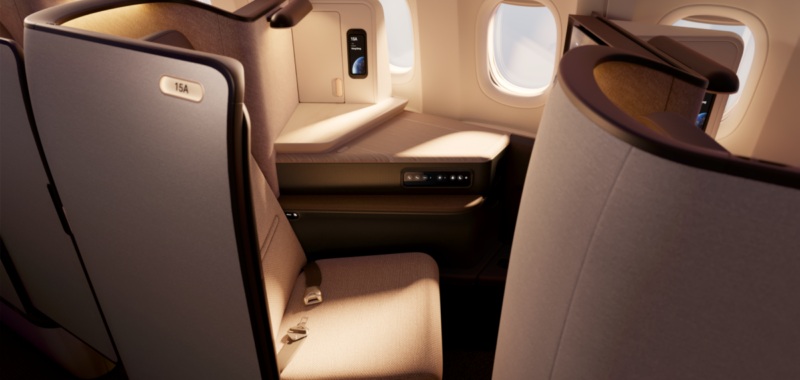For better or worse, our lives are lived through screens now. However, only one of aviation’s major seat-makers has an inflight entertainment (IFE) manufacturer in-house. And even then, the integration of its products into its seats has been glacial.
True integration between aircraft, seats, and those glossy 4K screens are only starting to reap rewards in the very latest cabins.
For example, controlling the seat — and your environment — from the screen, watching a movie with your travel companion, seeing at-a-glance which lavatories are occupied, and indicators for inflight Wi-Fi. Much of this is class-independent, with the same IFE system throughout the plane.
Daniel Clucas, founder of design agency Studio ID, predicts that changes to seating as we approach the end of the decade could initially appear subtle: “2030’s seats on the surface might not look too different to today… but the detailing and what’s under the skin will change significantly. Passenger control of their environment, with inbuilt heating and cooling, control over each and every light and comfort adjustment will be commonplace.”
‘New Levels of Immersion’
Individual heating and cooling reached the cabin with Lufthansa’s Allegris business class, while new cabins such as Cathay Pacific’s Aria allow for extensive seating and lighting adjustment. These include saving presets, controlled via the inflight entertainment system.
“In-seat entertainment will reach new levels of immersion, with larger, higher-resolution screens with sound and lighting within the suite enhancing the experience,” predicts Clucas.
“Of course this comes with challenges: keeping the experience personal and not broadcasting your light to the rest of the cabin will mean some smart physical design of the suites will be essential,” he adds.
This smart design will also need to include airframers, whose overhead bins and ceiling panels are the primary reflective surface for this light, as well as noise that’s increasingly audible in today’s quieter aircraft cabins.
Airbus and Boeing also need to consider how their own catalog and factory line-fit approvals process curtails innovation across the seating sector.
As LIFT Aero Design’s Daniel Baron explains, each planemaker has a list of approved seat models, and each seat model is certified for a particular aircraft type. “A seat model can be added to or removed from the list depending on the performance of the seat manufacturer. This means that often an airline can install a particular seat model on one of its fleets but not another. The result is less ability for the airline to deliver a consistent cabin experience, plus greater complexity and higher cost.”
Is Innovation Being Stifled?
All this, together with supply chain problems, skill shortages, industry consolidation and the airline equivalent of the maxim that no IT director ever got fired for buying IBM, combines to create an integration challenge and to stifle innovation.
As just one example, many major and startup seatmakers offer an outward-facing herringbone seat that is, to the average passenger, largely indistinguishable. As a result, it’s quite the challenge for airlines to distinguish their product from competitors.
At the same time, the Lufthansa Group is using three separate seatmakers to produce aircraft-specific implementations of its ‘FICE’ cabin (that’s Future InterContinental Experience.) The platform is being rolled out as Lufthansa Allegris and Swiss Senses across an extensive widebody fleet.
In the background of these competing challenges, LIFT’s Baron predicts that “the future may see fewer seat models but with approval for installation on more aircraft types. The next big thing will be convertibility: the ability to sell a seat as different products as a tool to mitigate shifts in market demand.
This is the last of three special insights from John Walton on cabin technology and trends to 2030. Below are links to the other stories in the series.
Airlines Sector Stock Index Performance Year-to-Date
What am I looking at? The performance of airline sector stocks within the ST200. The index includes companies publicly traded across global markets including network carriers, low-cost carriers, and other related companies.
The Skift Travel 200 (ST200) combines the financial performance of nearly 200 travel companies worth more than a trillion dollars into a single number. See more airlines sector financial performance.
Read the full methodology behind the Skift Travel 200.


